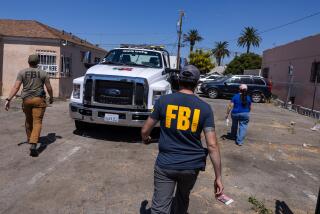Priceless Relics at Mexico City Museum Stolen
MEXICO CITY — Thieves stole 140 priceless Mayan, Aztec and other artifacts from Mexico’s world-famous National Museum of Anthropology on Christmas Eve in the biggest heist ever of pre-Columbian art objects, museum officials said Thursday.
One or more thieves pried open seven glass display cases in three exhibition halls and grabbed several of the museum’s best-known gold, jade, turquoise and obsidian objects. Mexican prosecutors detained and were interrogating the nine police guards assigned to the museum on the night of the theft.
Museum officials estimated the total value of the stolen goods at “many millions of dollars.” Both Mexican and U.S. experts emphasized, however, that it is difficult to set a specific worth because the artifacts are unique.
One of Biggest Thefts
“Nothing like this has ever been sold on international markets,” said Felipe Solis, a curator at the museum. He and several other experts said the burglary was one of the biggest museum thefts of all time.
The museum said in a statement that it believes the thieves are professionals who will probably try to sell the artifacts abroad. But several U.S. experts said the thieves have taken objects so well known that they will find it difficult to unload them.
“It’s like trying to fence the ‘Mona Lisa,’ ” Robert Childs, director of collections at the Los Angeles County Museum of Natural History, said in a telephone interview. Any unscrupulous collector who bought the stolen objects would have to “hoard them, because that’s all you can do with them,” he said.
A former New York dealer in pre-Columbian artifacts expressed fears for the fate of the objects when the thieves discover how difficult it is to sell them.
Afraid to Touch Them
“No reputable dealer would dare get even his fingerprints on them,” said the former dealer, who asked to remain anonymous. “The tragedy of this is that (the thieves) may become scared and destroy them,” he said.
The stolen objects are small and easy to transport, with the largest being only 10 inches in diameter. The best-known pieces include a jade mask from the Mayan ruins of Palenque in southern Mexico, an Aztec obsidian vase in the form of a monkey and a mask of the bat god Murcielago of the Zapotec culture.
The artifacts were made by the Indian cultures that flourished in Mexico from the 6th Century until the Spanish conquest in the 1500s. The thieves grabbed almost all the museum’s holdings of artifacts from two major Mayan finds: a king’s tomb at Palenque and a “sacred pool” at the well-known ruins of Chichen Itza in the Yucatan.
Theft Discovery Delayed
The theft was not discovered until the day shift of guards arrived at the museum Christmas morning at 8, museum authorities said. It was unclear how many thieves participated in the heist, how they entered the museum or how long they were there, the officials said.
The eight police guards and their officer assigned to the 12-hour shift on Christmas Eve were supposed to visit each room in the sprawling, modern museum at least once every hour, according to guards who were at the museum Thursday.
“They (the guards) are being interrogated. None have been charged with anything,” said Antonio Camargo, spokesman for the national institute that operates the museum.
The thieves apparently knew exactly what they were after. They left dozens of display cases untouched and cleaned out the ones containing the artifacts that were the most valuable and the easiest to transport.
‘Stole the Best Ones’
“The robbery didn’t happen by chance. They stole the best ones (objects) from each culture,” Camargo said.
Museum officials showed journalists the empty display cases Thursday, although the museum was closed until today while investigators took fingerprints and examined the grounds.
The thieves pried off the wooden moldings at the bottom of several cases and simply removed the panes of glass. The museum does not have an electronic alarm system, although officials said they had beefed up security only two months ago in ways they declined to discuss.
“We’ve never had problems before. I believed that the system functioned well, but times change,” curator Solis said.
Afternoon editions of the newspaper Excelsior reported Thursday that Interpol-Mexico was seeking information from other countries where archeological artifacts have been stolen.
It said notices were posted on highways and at all ports, airports and railroad stations, although six private planes had taken off from Mexico City’s international airport before the theft was reported.
Enrique Florescano, director of the museum, one of the city’s major tourist attractions, called the burglary “the biggest plundering that has been done to the Mexican archeological heritage.”
He also said that the burglary, “by its scale and dimension,” has to be linked to the international traffic in cultural and archeological treasures, which he said is a “constant threat to all museums in the world.”
Florescano said the stolen pieces could not be sold within Mexico and probably would be smuggled out of the country for sale to international collectors.
Museum official Mario Vazquez said, “It is the cultural root of the Mexicans that they have robbed from us.”
“These are famous, old pieces. . . . They’ve illustrated lots of literature,” said National Geographic Society archeologist George Stuart, adding that the pieces are too famous to be displayed by the thieves.
“I guess they could sell them to somebody, but they could never be shown. They’re as hot as the Mona Lisa would be if it were for sale on the illicit market,” Stuart said in Washington.
The museum described the crime as the latest in a series of major art thefts in Europe, the United States, Africa and Asia.
‘Linked With World Traffic’
“Such important and valuable objects . . . were taken by criminal hands that, surely, are linked with the world traffic in cultural objects that constantly threatens all of the world’s museums,” a museum statement said.
“Unfortunately, the removal of pieces that the museum has just suffered joins the wave of robberies that have affected the principal museums of the world in recent years,” the statement added.
The most recent major theft of pre-Columbian artifacts took place over Labor Day weekend in 1982 when thieves stole 25 Mayan jade ornaments valued at approximately $500,000 from the Museum of Natural History in New York City. Four of the ornaments were recovered later in Brussels when a dealer became suspicious and the holder of the objects abandoned them. That theft remains unsolved.
Looting of archeological treasures from the thousands of sites in Mexico has been a persistent problem for years. Archeologists say the looting in modern times is stimulated by collectors who are often motivated by investment rather than artistic and historical interest.
The main market for ancient artifacts appears to have switched to Europe from the United States, which has an agreement with Mexico and other countries to return stolen pieces.
More to Read
Sign up for Essential California
The most important California stories and recommendations in your inbox every morning.
You may occasionally receive promotional content from the Los Angeles Times.










